Art festivals tend to start with press conferences and cocktail receptions. This is the first I’ve attended that’s kicked off with a quasi-religious dedicatory ritual. But then Khanyisile Mbongwa, the South African curator of the 12th edition of the Liverpool Biennial – Britain’s largest art festival – is a sangoma, a traditional healer, as well as an artist.
It started with Mbongwa kneeling on Liverpool’s quayside beside a monumental vessel-shaped sculpture formed from recycled fishing nets, created by Taiwanese artist Eleng Luluan. Next to her, Luluan – dressed in brilliantly embroidered clothes and a headdress with dangling silver ornaments – joined in a murmured propitiatory ceremony, with offerings including a packet of cigarettes, while a gigantic white cruise liner loomed in the background.
While this ceremony wasn’t billed among the biennial’s opening events, it set the tone for a festival that sets out to address the past injustices of slavery and colonialism, but is focused at least as much on the realm of the spiritual as that of the historical and political.
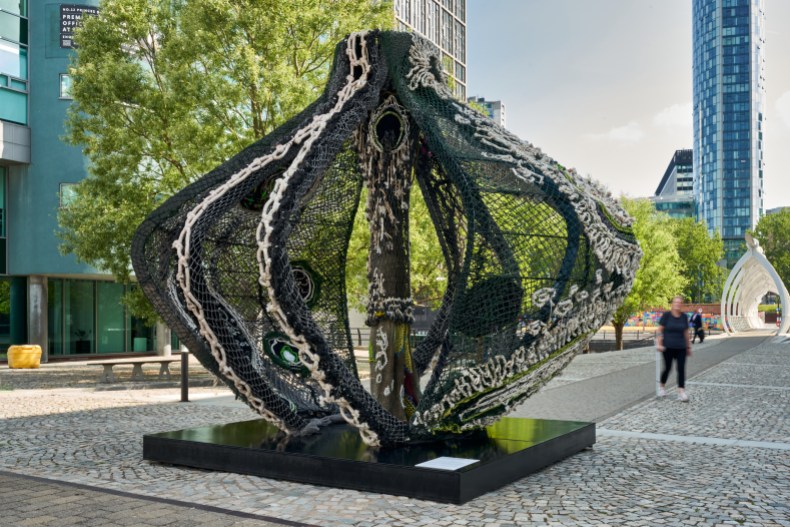
Installation view of Ngialibalibade to the Lost Myth (2023) by Eleng Luluan at the Liverpool Biennial 2023. Photo: Rob Battersby; courtesy Liverpool Biennial
Titled ‘uMoya: The Sacred Return of Lost Things’, and featuring 35 artists from countries on six continents this biennial is based around a ‘call for ancestral and Indigenous forms of knowledge and healing’. UMoya, an isiZulu word meaning either spirit, breath, air, climate or wind, refers here to the chill breeze that Mbongwa felt on her first visit to Liverpool – as she puts it, ‘the same wind that made Liverpool a key location in the trade of enslaved peoples’. Her festival aims to extend the notion of ‘care’ into a healing of historic wounds that bleed into today, and one that goes well beyond simply telling people what happened.
Looming out of the dimness of Tate Liverpool’s ground-floor galleries are massive hull-like forms in steel and painted brass by American artist Torkwase Dyson, which speak to their context within the surrounding Old Dock, built in 1715 to expedite the transatlantic slave trade. While slave ships were, of course, made of wood rather than metal, the triangular voids cut through these monumental forms may, the wall texts tell us, signify a gateway through the oceanic depths into which millions of Africans were thrown, either deemed sick and worthless or murdered for their insurance value. This ghostly underwater space is referred to in numerous works throughout the biennial; it seems to have become the principal point of imaginative remembrance for the slave trade.
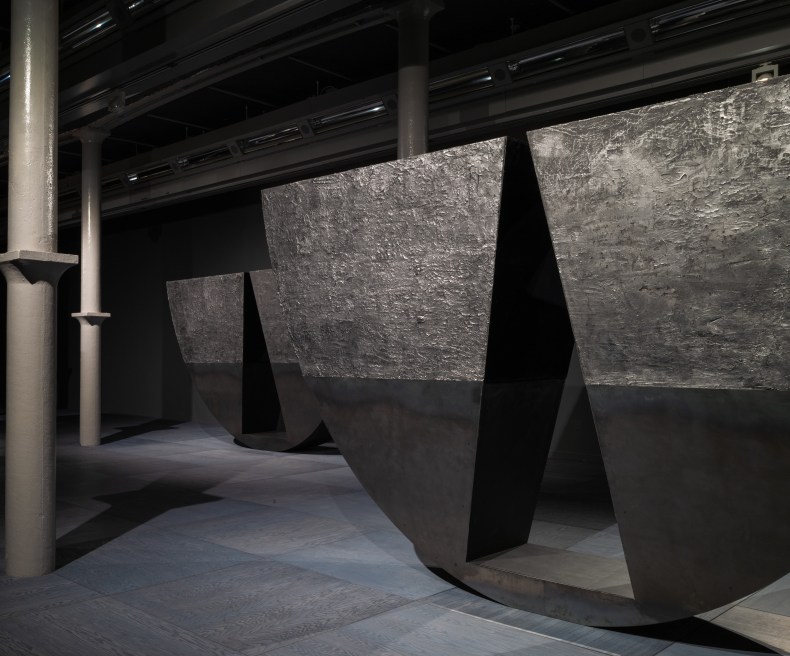
Liquid A Place (2021) by Torkwase Dyson at the Liverpool Biennial 2023. Photo: Mark McNulty; courtesy Liverpool Biennial
The notion expounded in Dyson’s wall texts that water as a ‘space’ may be experienced in particular ways by ‘Black and Brown bodies’ is extended by South Africa-based artist Nolan Oswald Dennis, whose wall-filling diagrams attempt to map a ‘Black consciousness of space and time’. But most of the work in the Tate displays is folksier in feel. Textile collages by Brazilian artist Iso do Rosário act as ex-votos entreating the Orixás, deities of Afro-Brazilian religions Candomblé and Umbanda, to grant ‘safe passage’ to the souls of drowned slaves.
Phantasmagorical structures titled Disease Throwers by Guadalupe Maravilla are designed as ‘wearable shrines’. The works by the El Salvador-born American artist are formed from masses of marine detritus, seaweed, loofahs and cheap plastic toys, they also incorporate gongs and flutes that were sounded in the shamanic ceremonies with which the artist was treated for cancer. There’s a sense of rootedness in tradition in the Tate’s displays that continues into the biennial’s other venues, including the palatial but ruinous Cotton Exchange and the colossal quayside Tobacco Warehouse.
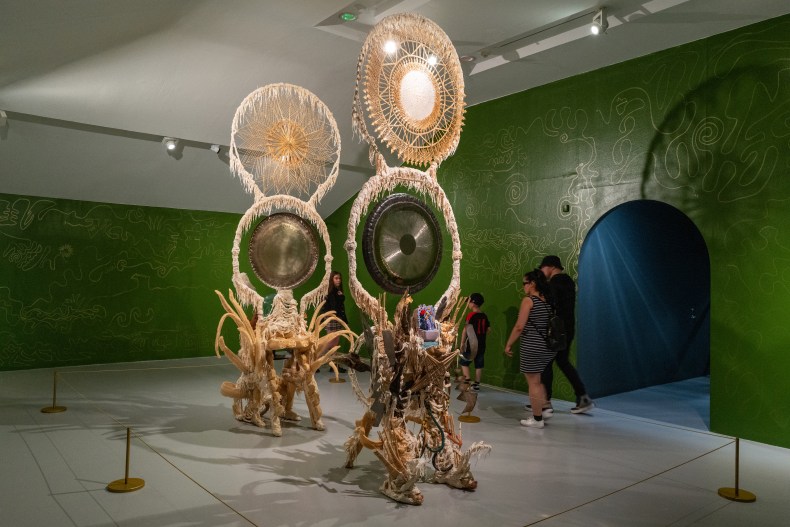
Installation view of Disease Thrower #8 and Disease Thrower #9 (both 2019) by Guadalupe Maravilla at the Liverpool Biennial 2023. Photo: Mark McNulty; courtesy Liverpool Biennial
While the Liverpool Biennial has become notable for unearthing remarkable new exhibition spaces in historic buildings, these venues – for all their scale – have yielded only small amounts of space in which to show artworks. This makes progress around the festival a rather bitty experience, while the mood of wistful recollection and ancestral affirmation feels a little too one-note; I found myself longing for a change in gear. Both Songs to Earth, Songs to Seeds (2022), Sepideh Rahaa’s beautiful film about traditional rice cultivation in Iran, and an intriguing installation on the ‘cultural politics of cloth’ by Raisa Kabir don’t go far enough beyond simply telling us that the respective phenomena exist. Anyone coming to Liverpool for a sense of the future direction of art might conclude that a preoccupation with identity, in which who you are is as important as what you do, can become constricting.
In another context, Chorus of Soil (2023) by Binta Diaw might have made a powerful impression: a near-1:1 plan of an 18th-century slave ship, with 130 seedling-filled beds of soil – creating new life – standing in for the people thrown from a Liverpool-registered slave ship in 1781. But here, crowded into the Tobacco Warehouse among many works of a similar mood, it feels rather lost.
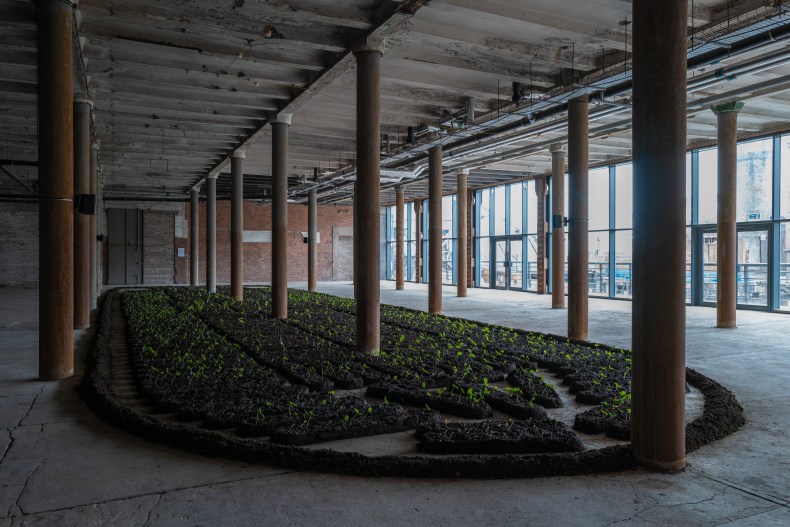
Installation view of Chorus of Soil (2023) by Binta Diaw at the Liverpool Biennial 2023. Photo: Mark McNulty; courtesy Liverpool Biennial
A waspish comment by Singaporean artist Kent Chan on the obsession of museums with temperature control and preservation – featuring a (replica) African mask in a plastic steam tent – stands out for its irreverence and humour, and because Chan isn’t claiming an ancestral connection to his source material. Australian artist Brook Andrew’s video commentary on ‘colonial archiving’ and Aboriginal experience – a wild digital mash-up with a slamming techno soundtrack – also disrupts the prevailing reverential mood.
The most compelling and challenging works I experienced were two performances. In The Black Circus of the Republic of Bantu, South African artist Albert Ibokwe Khoza informed us, over the course of an hour of dancing, nudity and hilarious audience humiliation, that ‘the children of the colonialists’ – i.e. most of those present – are condemned to perpetuate the ‘imperial gaze’, reducing him to the status of a performing monkey. In St Luke’s Church, Lorin Sookool, another South African artist, interpreted the ‘dancing body as a previously colonised state’ in a truly virtuosic solo performance.
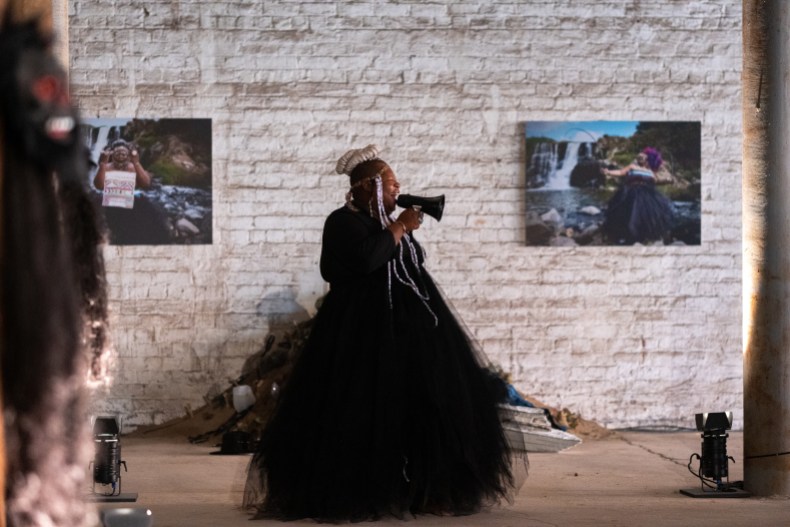
Albert Ibokwe Khoza performing The Black Circus of the Republic of Bantu (2023) at the Liverpool Biennial 2023. Photo: Mark McNulty; courtesy Liverpool Biennial
These moments stood out not only for their outright provocation, but also because – as with that quayside dedication ceremony – art rooted in ancestral spiritual traditions is perhaps best experienced in the company of other people, its forms and objects put into social and ritual use, rather than left to sit on its arse in a museum (to paraphrase Claes Oldenburg). Now that is one lesson contemporary art could take from this sometimes limited, but brave and valuable event.
I’ve been to editions of the Liverpool Biennial that worked better in terms of scale and pace, though I can’t for the life of me remember what they were about. This one takes the bold step of going beyond the standard confines of Western art curation in ways visitors won’t forget in a hurry. It needs to be seen – and reflected on.
The Liverpool Biennial of Contemporary Art takes place at various venues from 10 June–17 September.
Unlimited access from just $16 every 3 months
Subscribe to get unlimited and exclusive access to the top art stories, interviews and exhibition reviews.


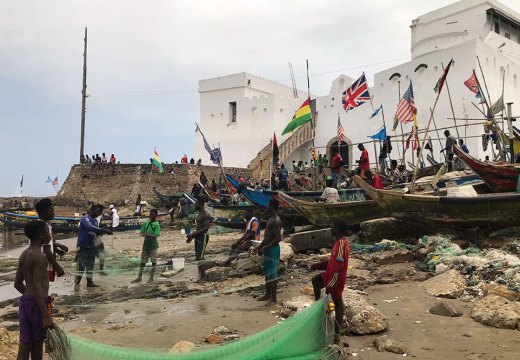
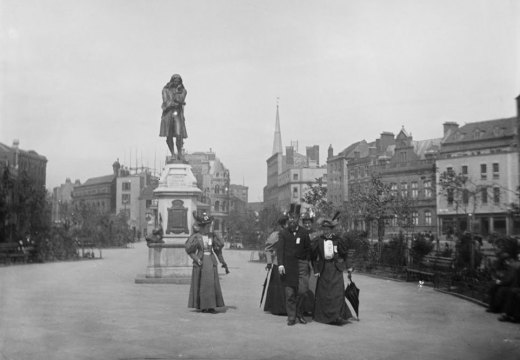
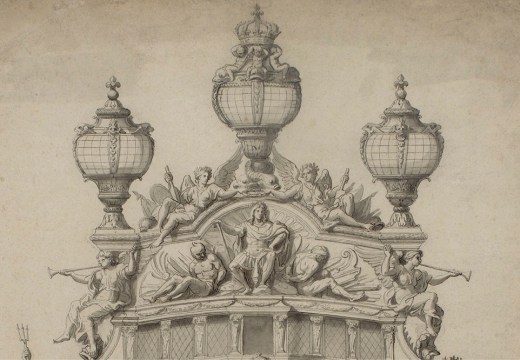









![Masterpiece [Re]discovery 2022. Photo: Ben Fisher Photography, courtesy of Masterpiece London](http://www.apollo-magazine.com/wp-content/uploads/2022/07/MPL2022_4263.jpg)
Has arts punditry become a perk for politicos?